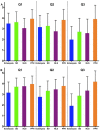Evaluation of learning from Practical Obstetric Multi-Professional Training and its impact on patient outcomes in Australia using Kirkpatrick's framework: a mixed methods study
- PMID: 29455162
- PMCID: PMC5855459
- DOI: 10.1136/bmjopen-2017-017451
Evaluation of learning from Practical Obstetric Multi-Professional Training and its impact on patient outcomes in Australia using Kirkpatrick's framework: a mixed methods study
Abstract
Objectives: The aim of this study was to evaluate the implementation of the Practical Obstetric Multi-Professional Training (PROMPT) simulation using the Kirkpatrick's framework. We explored participants' acquisition of knowledge and skills, its impact on clinical outcomes and organisational change to integrate the PROMPT programme as a credentialing tool. We also aimed to assess participants' perception of usefulness of PROMPT in their clinical practice.
Study design: Mixed methods approach with a pre-test/post-test design.
Setting: Healthcare network providing obstetric care in Victoria, Australia.
Participants: Medical and midwifery staff attending PROMPT between 2013 and 2015 (n=508); clinical outcomes were evaluated in two cohorts: 2011-2012 (n=15 361 births) and 2014-2015 (n=12 388 births).
Intervention: Attendance of the PROMPT programme, a simulation programme taught in multidisciplinary teams to facilitate teaching emergency obstetric skills.
Main outcome measure: Clinical outcomes compared before and after embedding PROMPT in educational practice.
Secondary outcome measure: Assessment of knowledge gained by participants through a qualitative analysis and description of process of embedding PROMPT in educational practice.
Results: There was a change in the management of postpartum haemorrhage by early recognition and intervention. The key learning themes described by participants were being prepared with a prior understanding of procedures and equipment, communication, leadership and learning in a safe, supportive environment. Participants reported a positive learning experience and increase in confidence in managing emergency obstetric situations through the PROMPT programme, which was perceived as a realistic demonstration of the emergencies.
Conclusion: Participants reported an improvement of both clinical and non-technical skills highlighting principles of teamwork, communication, leadership and prioritisation in an emergency situation. An improvement was observed in management of postpartum haemorrhage, but no significant change was noted in clinical outcomes over a 2-year period after PROMPT. However, the skills acquired by medical and midwifery staff justify embedding PROMPT in educational programmes.
Keywords: evaluation; interprofessional education; interprofessional learning; patient outcome; simulation.
© Article author(s) (or their employer(s) unless otherwise stated in the text of the article) 2018. All rights reserved. No commercial use is permitted unless otherwise expressly granted.
Conflict of interest statement
Competing interests: The authors MS, PN, DL, SalS and JM are involved in the delivery of PROMPT at their hospital but have no financial involvement.
Figures

References
-
- Barr H, Koppel I, Reeves S, et al. . Effective Interprofessional Education: Argument. Assumption and Evidence: Blackwell Publishing Ltd, 2005.
Publication types
MeSH terms
LinkOut - more resources
Full Text Sources
Other Literature Sources
